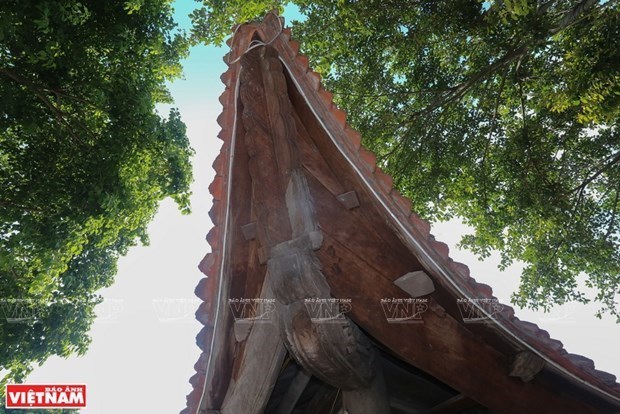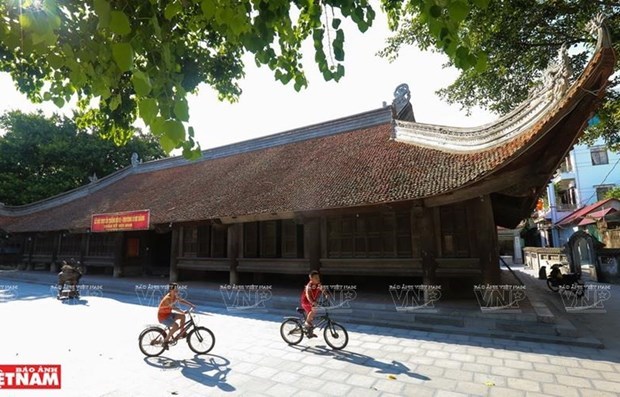Ancient features of Dinh Bang communal house
 The roof of the communal house is one of the largest of its kind in Vietnam (Source: Vietnam Pictorial)
The roof of the communal house is one of the largest of its kind in Vietnam (Source: Vietnam Pictorial)Hanoi (VNA) - As a massive ancient structure containing unique traditional wooden art decoration values, Dinh Bang communal house in Tu Son town, northern Bac Ninh province, has long been considered one of the three most beautiful communal houses in the region formerly called Kinh Bac (Northern Region) – a land with a long history and ancient culture.
The communal house is about 20km north of the capital city of Hanoi.
The construction of Dinh Bang communal house was initiated by a mandarin in the village namely Nguyen Thac Luong. He and his spouse Nguyen Thi Nguyen along with locals in the region donated workdays and money to build the communal house.
Dinh Bang house is used for worshipping Cao Son Dai Vuong (Mountain Spirit), Thuy Ba Dai Vuong (Water Spirit), and Bach Le Dai Vuong (God of Agriculture), together with the six individuals who rebuilt the village in the 15th century after it was devastated during the Ming occupation (1408-1428).
The communal house is located on a high ground and faces the south. It was surrounded by 17 lakes – which were the remains of Tien Luong (or Tieu Thong) river, a canal which was linked to the Duong River and served as a convenient water way for the Kings of the Ly dynasty (1009-1225) to come to visit the area from Thang Long, the then royal capital. Yet only a small lake in front of the communal house still exists.
Long ago, it had a three-entrance gate with a left wing and a right wing. It was destroyed during the wartime. There now remain only the Hall of Ceremonies and a corridor leading to the Inner Room.
The Hall of Ceremonies is 20 metres long, 14 metres large and comprises seven smaller compartments and two wings. Its elevated floor is covered with blue stones and stairs. The roof is supported by 60 ironwood columns and a framework of valuable wood, which are elaborately sculptured with common images such as dragon figures.
Two big ceremonies held annually in Dinh Bang communal house are the traditional festival on the 12th day of the second lunar month and the festival in commemoration of the establishment of the Ly dynasty on the 15th day of the third lunar month.
The communal house’s interior is decorated with many themes such as dragon, phoenix, pine, apricot, bamboo, wine gourd, and sword. In particular, the dragon image occupies a large proportion with about 500 images totally. The main hall (the nave) has a low floor which is paved with “nem” leaf tiles. This space is the lowest part called "boat bed". The plank floors of the two sides are gradually higher with two levels, distinguishing the status of the officials, who sit "upper" or "below" depending on their position in the village.
Previously, Kinh Bac consisted of Bac Giang province and Dong Anh and Long Bien districts of Hanoi. The region is associated with several legends and is considered the cradle of the Dai Viet (Great Viet) civilization.
Located in the center of the Red River Delta, Kinh Bac is blessed with fertile land, beautiful landscapes and favorable conditions for economic and cultural exchanges with other localities throughout the country.
Since the early years before Christ, the region was one of the cradles of the wet rice civilization and the founding place of the Great Viet civilization. It is home to several relics, pagodas, towers, temples and stupas which were built under several feudal regimes.
Kinh Bac is also famous nationwide for its folk festivals, especially Quan Ho folk singing, an art form that combines various elements, including music, lyrics and costumes, and features the distinctive culture of people in the region formerly called Kinh Bac.
The singing represents different kinds of relationships -- the relationship between male and female singers as romantic lovers, the relationship between two friendly villages and the relationship between performers and the audience. Each element helps define quan ho, give it life and meaning, and the resulting harmony is so much more than just a beautiful song.
From only 49 original Quan ho villages and 34 clubs, there are now 369 Quan ho villages and 381 clubs with over 10,000 members. Especially, more than 140 clubs are run in other provinces and by overseas Vietnamese communities.
The art of love duets was inscribed in UNESCO’s representative list of intangible cultural heritage in September 2009./.












